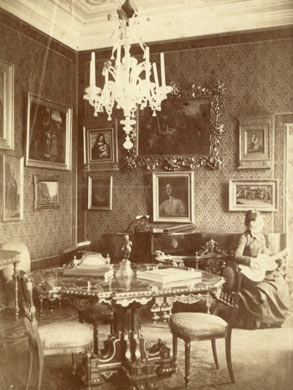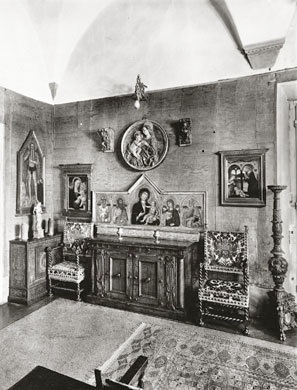The library's department of image collections serves as a vital component of the vast resources for art historical research at the National Gallery of Art, including the library, vertical files, curatorial records, Gallery Archives, and the Gallery's art collection itself. The image collections comprise more than 15 million items representing the entire history of Western art, from the caves of Lascaux to the wall drawings of Sol LeWitt. While the principal collecting focus of the collection is Western art, a small number of non-Western subjects are also included. Photographs are generally acquired through purchases from museums or photographers, gifts from scholars, and exchanges with other institutions. Because of this significant range of sources and the department’s long history at the Gallery, the collection documents not only the history of art but also its reproduction through photomechanical and reproductive prints and a wide span of photographic processes dating back to the mid-19th century and encompassing the digital revolution of the present day.
The seeds of the National Gallery of Art photographic archives, the photograph component of the image collections, were planted in 1943 when Solomon R. Guggenheim gave funds to the young museum to purchase the Richter Archive of Illustrations on Art. This archive, created by George M. Richter (1875–1942), a collector and authority on Renaissance art, consisted of 60,000 photographs and clippings from books and catalogues. All European schools were represented in the collection, with special concentration in Italian painting.
A National Gallery of Art press release of August 4, 1943, emphasizes the Richter Archive's importance for scholarship in Washington, specifically for research on the Gallery’s holdings. The acquisition was particularly timely because of growing concern for art and architecture lost or destroyed in World War II. The Gallery's statement points out that "the photographs...will be an invaluable record of many works of art from great European museums now either destroyed or dispersed. The photographs of paintings in private collections, to which Mr. Richter had access, are in many cases unique, and may be of great assistance in establishing the rightful ownership of works of art when the war is over."
History of the Image Collections

Louise M. Richter playing guitar in the Jean Paul Richter home, 1887

Collection of Harold Acton. Photograph Foto Reali
The Richter Archive proved to be such a useful resource that plans were announced in 1970 to establish a photographic archives at the Gallery with the Richter gift as its core. Through a generous start-up grant and the promise of continued support from the Samuel H. Kress Foundation, Alessandro "Sandrino" Contini-Bonacossi was hired in September 1970 as the archives' first curator.[1] Contini-Bonacossi, who had previously served as a curator at the Samuel H. Kress Foundation, quickly began the task of amassing what the foundation's vice president described as "one of the great photographic collections of the world."[2] The press deemed the collection "The World's Largest Photo Album."[3]
A year later, the photographic archives was well on its way to the announced goal of collecting 2.5 million photographs. In July 1971 the purchase of approximately 130,000 negatives from the Parke-Bernet auctions and the gift of the Clarence Ward Medieval Architecture Archive nearly doubled the holdings. Other acquisitions soon followed, including the purchase of the Foto Reali and Gramstorff negatives, as well as the complete offerings of Fratelli Alinari. Contini also initiated the Archives' associations with Zodiaque and the Corpus Photographicum of Drawings.

Distant view of pyramids. Photograph W. Hammerschmidt
Heading the photographic archives until his death in 1975, Contini-Bonacossi was succeeded by Ruth Philbrick, who came to the Gallery after many years at the Epstein Archive at the University of Chicago. She continued to strengthen the archives by seeking out notable commercial and private collections. Among the numerous important collections acquired in her tenure are the René Huyghe and Venturi/Rewald archives, the archives of the Witt Library and the Conway Library on microfiche, and images from Art International and the Munich Central Collecting Point. After Philbrick retired in 2004, the photographic archives and the slide library, established in 1941 as a teaching tool, were merged into a single resource with Gregory P. J. Most as the head of the department. He has continued to expand the collection with the addition of a digital imaging program, the acquisition of the Paul Katz Archive of portraits of artists, and the Cleveland Museum of Art Photograph Library and its extensive non-Western holdings, in addition to rare photographs and albums that document the history of art and architecture.
The department of image collections has also been shaped by other departments at the Gallery, especially the curatorial offices. One result of such reciprocal relationships is the exhibition archive, which contains photographs, transparencies, and negatives documenting objects from every exhibition in the Gallery's history.[4]
The department of image collections now consists of nearly 7 million black-and-white photographs and negatives and more than 7 million microform and digital images. Thanks to the devotion of curators, staff, generous private donors, and the ongoing support of the Samuel H. Kress Foundation, the collection is one of the most extensive of images of art and architecture in the world.
NOTES
1. His uncle (of the same name) had served as an art advisor and dealer to Samuel H. Kress.
2. Mary M. Davis, then vice president of the Samuel H. Kress Foundation, to J. Carter Brown, then director of the National Gallery of Art, May 6, 1970.
3. San Francisco Chronicle, October 23, 1970.
4. This collection does not, however, include installation shots from exhibitions; these are preserved in Gallery Archives.
The library is open Monday through Friday 11:00 a.m. to 4:30 p.m. We are closed Saturday, Sunday, and federal holidays.
To help us prepare materials ahead of your initial visit, we recommend you request an appointment.
Location
National Gallery of Art East Building
4th Street and Pennsylvania Avenue NW
Washington, DC
Mailing Address
Image Collections
National Gallery of Art
2000 South Club Drive
Landover, MD 20785
Contact [email protected] or call (202) 842-6026
Travels Across Russia: Oranienbaum
In Situ: Henry Moore, David Finn, and the Experience of Location
Verrocchio, Connoisseurship, and the Photographs of Clarence Kennedy
Before the Fire: Notre-Dame de Paris in Pictures
Travels Across Russia: Avant-Garde Architecture in Moscow
John Brampton Philpot and Photography in 19th-Century Florence
Beauty, Fire, & Memory: Lost Art of the Kaiser-Friedrich-Museum
Process and Participation in the Work of Christo and Jeanne-Claude
Revelations from Reproductions:
Fifteenth-century Italian Paintings in the National Gallery of Art
The Solemnity of Shadows: Juan Laurent’s Vision of Spain
Patrimony in Peril: Germany’s Survey of Mural Paintings Threatened During World War II
War Damage in Baden and Württemberg: Monuments Men Albums
Travels across Russia: Ekaterinburg
Travels Across Russia: Torzhok
United States Centennial International Exhibition
Philadelphia - 1876